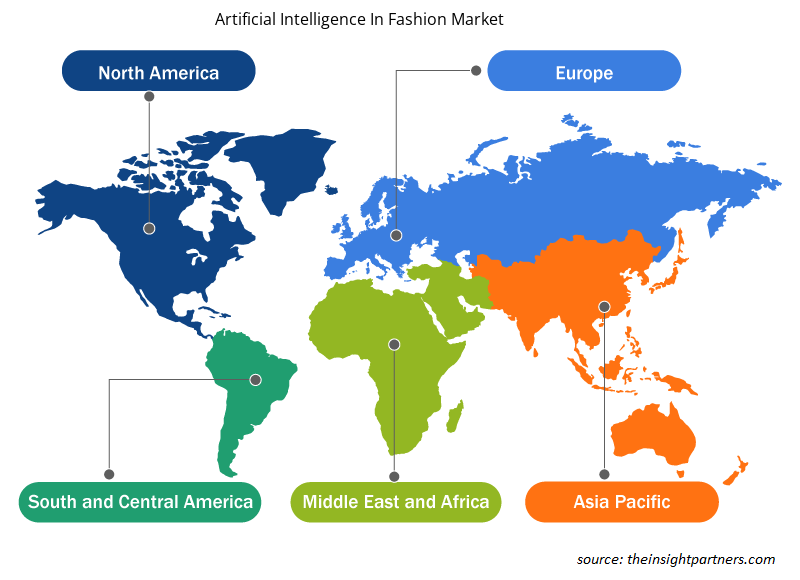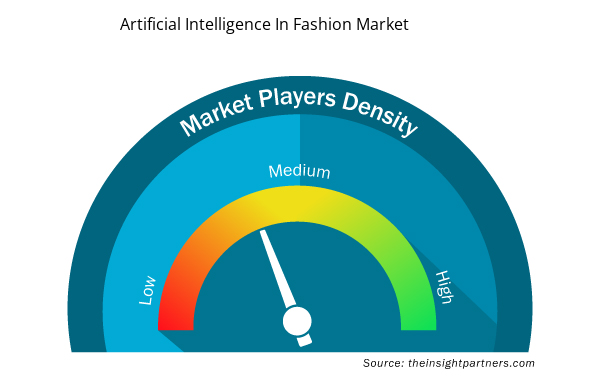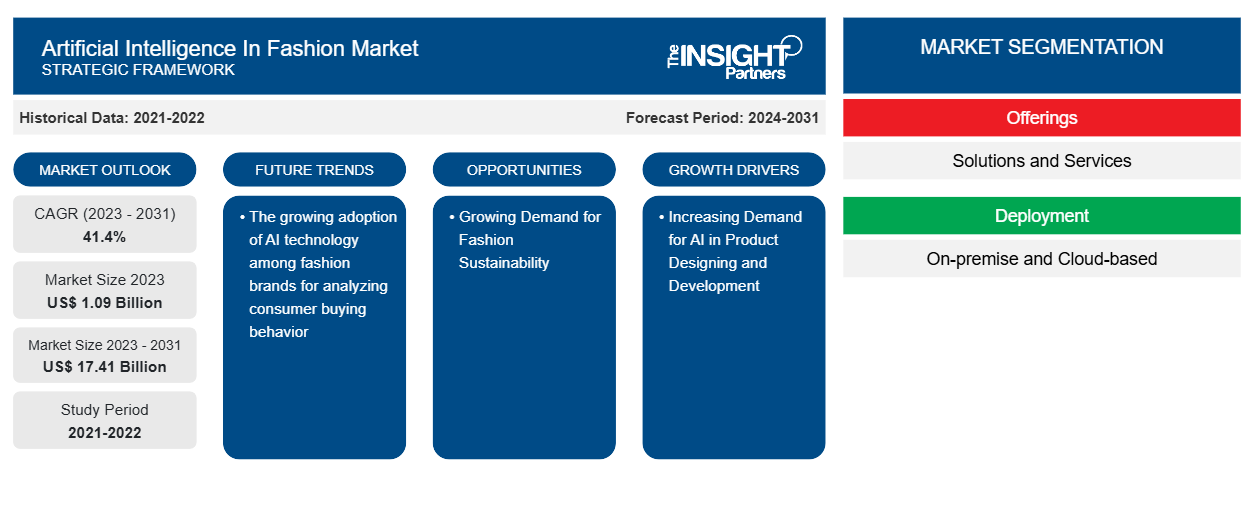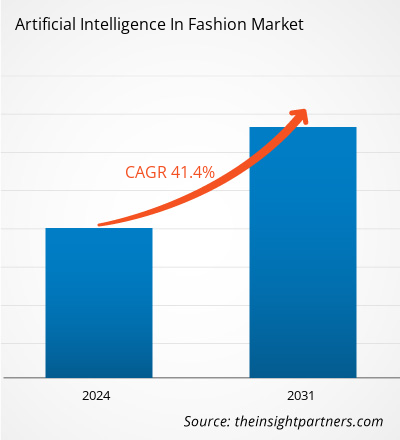من المتوقع أن يصل حجم سوق الذكاء الاصطناعي في الموضة إلى 17.41 مليار دولار أمريكي بحلول عام 2031 من 1.09 مليار دولار أمريكي في عام 2023. ومن المتوقع أن يسجل السوق معدل نمو سنوي مركب بنسبة 41.4٪ في الفترة 2023-2031. ومن المرجح أن يظل التبني المتزايد لتقنية الذكاء الاصطناعي بين العلامات التجارية للأزياء لتحليل سلوك الشراء لدى المستهلك أحد أهم أشكال الذكاء الاصطناعي في اتجاهات سوق الموضة.
تحليل سوق الذكاء الاصطناعي في مجال الأزياء
يشهد سوق الأزياء نموًا سريعًا بسبب الطلب المتزايد على الذكاء الاصطناعي في تصميم وتطوير المنتجات والطلب المرتفع من العملاء على تجربة شخصية. يتوسع السوق بشكل مطرد، مدفوعًا بالطلب المتزايد على الذكاء الاصطناعي لإدارة المخزون. علاوة على ذلك، يوفر الطلب المتزايد على استدامة الأزياء ونمو تجارة التجزئة للأزياء السريعة فرصًا مربحة لنمو السوق.
نظرة عامة على سوق الذكاء الاصطناعي في عالم الأزياء
يعمل الذكاء الاصطناعي على تحويل صناعة الأزياء من خلال تحسين العديد من مجالات دورة حياة المنتج وإعادة تعريف كيفية إنتاج الملابس وبيعها وارتدائها. توفر التكنولوجيا المتطورة قدرات تحويلية للمصممين وتجار التجزئة والمستهلكين. يستخدم مصممو الأزياء الذكاء الاصطناعي لتعظيم إمكاناتهم الإبداعية ودفع الابتكار في التصميم. قد ينتج المصممون أفكارًا جديدة ومبتكرة باستخدام خوارزميات الذكاء الاصطناعي لفحص كميات هائلة من بيانات الموضة التاريخية وتحديد الاتجاهات المحتملة في صناعة الأزياء.
تعمل أنظمة التوصية المدعومة بالذكاء الاصطناعي على تحسين تجربة شراء العملاء من خلال تقديم اقتراحات فردية للمنتجات بناءً على اهتمامات الأفراد. يدعم الذكاء الاصطناعي العلامات التجارية للأزياء في تقييم بيانات المستخدم مثل سجل التصفح وسلوك الشراء وتفضيلات الأسلوب وإنشاء اقتراحات مخصصة بناءً على أذواق واهتمامات المستهلكين. يعمل هذا التخصيص على تحسين مشاركة العملاء وبناء ولاء العلامة التجارية وزيادة تحويلات المبيعات.
قم بتخصيص هذا التقرير ليناسب متطلباتك
ستحصل على تخصيص لأي تقرير - مجانًا - بما في ذلك أجزاء من هذا التقرير، أو تحليل على مستوى الدولة، وحزمة بيانات Excel، بالإضافة إلى الاستفادة من العروض والخصومات الرائعة للشركات الناشئة والجامعات
- احصل على أهم اتجاهات السوق الرئيسية لهذا التقرير.ستتضمن هذه العينة المجانية تحليلاً للبيانات، بدءًا من اتجاهات السوق وحتى التقديرات والتوقعات.
الذكاء الاصطناعي في سوق الأزياء: العوامل المحركة والفرص
الطلب المتزايد على الذكاء الاصطناعي في تصميم وتطوير المنتجات هو المحرك للسوق
تلعب الذكاء الاصطناعي دورًا مهمًا في تصميم وتطوير المنتجات في صناعة الأزياء. لقد قامت الصناعة بدمج أدوات مدعومة بالذكاء الاصطناعي بشكل كامل في العمليات الإبداعية لتبسيط وتحسين العديد من جوانب التصميم، وزيادة الكفاءة وتشجيع الابتكار طوال دورة حياة المنتج . يتم استخدام الذكاء الاصطناعي بشكل كبير لتحسين النمط في تصميم المنتج وتعظيم كفاءة المواد التي تقود السوق. تفحص خوارزميات الذكاء الاصطناعي معايير التصميم وصفات المواد لتطوير أنماط مثالية تقلل من النفايات مع تعظيم استخدام الموارد. تساعد التكنولوجيا أيضًا المصممين في تلبية أهداف توفير التكاليف والاستدامة البيئية مع الحفاظ على سلامة التصميم. ومن المتوقع أن تغذي هذه العوامل السوق خلال فترة التنبؤ.
الطلب المتزايد على استدامة الموضة – فرصة في سوق الذكاء الاصطناعي في الموضة
تركز صناعة الأزياء بشكل متزايد على الأساليب المستدامة والتوريد الأخلاقي للمواد. تلعب الذكاء الاصطناعي دورًا مهمًا في تسهيل اختيار المواد المستدامة للمنتجات، وتوفير رؤى حيوية ومساعدة لشركات الأزياء. تساعد خوارزميات الذكاء الاصطناعي في فحص العديد من العناصر أثناء تقييم المواد من أجل الاستدامة. تتضمن هذه العناصر إجراءات التوريد الأخلاقية، واعتبارات فعالية التكلفة، ودراسات التأثير البيئي. من خلال تقييم مجموعات البيانات الكبيرة والعوامل المعقدة، يسمح الذكاء الاصطناعي لشركات الأزياء باتخاذ قرارات مستنيرة بشأن المواد المستخدمة في منتجاتها وموازنة تطلعات الاستدامة مع أهداف العمل.
علاوة على ذلك، فإن ارتفاع وعي المستهلكين والمخاوف البيئية يزيد من اعتماد خوارزميات الذكاء الاصطناعي لتلبية الحاجة المتزايدة للأزياء المستدامة. إن القلق المتزايد بين المستهلكين فيما يتعلق بالتأثير البيئي للملابس يشجع العلامات التجارية للأزياء على تنفيذ ممارسات مستدامة في جميع أنحاء سلاسل التصنيع والتوريد الخاصة بها. هذه العوامل تولد فرص نمو كبيرة للسوق.
تحليل تجزئة تقرير سوق الذكاء الاصطناعي في مجال الأزياء
إن القطاعات الرئيسية التي ساهمت في اشتقاق تحليل سوق الذكاء الاصطناعي في مجال الأزياء هي قطاع العروض والنشر والتطبيق وصناعة المستخدم النهائي.
- بناءً على العروض المقدمة، ينقسم سوق الذكاء الاصطناعي في مجال الأزياء إلى حلول وخدمات. وقد استحوذ قطاع الحلول على حصة سوقية أكبر في عام 2023.
- على أساس النشر، ينقسم السوق إلى سوق محلي وسوق قائم على السحابة. وقد استحوذ قطاع السوق القائم على السحابة على حصة سوقية أكبر في عام 2023.
- بناءً على التطبيق، ينقسم سوق الذكاء الاصطناعي في الموضة إلى التوصية بالمنتج، والمساعد الافتراضي، والبحث عن المنتج واكتشافه، والتصميم الإبداعي وتوقع الاتجاهات، وإدارة علاقات العملاء، وغيرها. احتل قطاع التوصية بالمنتج حصة سوقية أكبر في عام 2023.
- من حيث صناعة المستخدم النهائي، يتم تصنيف الذكاء الاصطناعي في سوق الأزياء على أنه الملابس والإكسسوارات ومستحضرات التجميل وغيرها. احتل قطاع الملابس حصة سوقية أكبر في عام 2023.
تحليل حصة سوق الذكاء الاصطناعي في الأزياء حسب المنطقة الجغرافية
ينقسم النطاق الجغرافي لتقرير سوق الذكاء الاصطناعي في الموضة بشكل أساسي إلى خمس مناطق: أمريكا الشمالية، ومنطقة آسيا والمحيط الهادئ، وأوروبا، والشرق الأوسط وأفريقيا، وأمريكا الجنوبية/أمريكا الجنوبية والوسطى.
من حيث الإيرادات، استحوذت سوق أمريكا الشمالية على أكبر حصة في سوق الذكاء الاصطناعي في مجال الأزياء، وذلك بسبب التبني المتزايد لتكنولوجيا الذكاء الاصطناعي في صناعة الأزياء. إن التحسينات التكنولوجية والاستخدام المبكر للذكاء الاصطناعي في تطبيقات الأزياء هي التي تدفع السوق. وبالمثل، فإن اتجاهات الموضة الناشئة في دول مثل الولايات المتحدة وكندا تزيد من الطلب على تكنولوجيا الذكاء الاصطناعي لتعزيز الإنتاجية وتحسين المبيعات والاستدامة. بالإضافة إلى ذلك، فإن الطبيعة الديناميكية لصناعة الأزياء والتغيرات المستمرة في الطلب الاستهلاكي تزيد من الطلب على الذكاء الاصطناعي لدفع الابتكار والمنافسة.
الذكاء الاصطناعي في سوق الأزياء: رؤى إقليمية
لقد قام المحللون في Insight Partners بشرح الاتجاهات والعوامل الإقليمية المؤثرة على سوق الذكاء الاصطناعي في الموضة طوال فترة التوقعات بشكل شامل. يناقش هذا القسم أيضًا قطاعات سوق الذكاء الاصطناعي في الموضة والجغرافيا في جميع أنحاء أمريكا الشمالية وأوروبا ومنطقة آسيا والمحيط الهادئ والشرق الأوسط وأفريقيا وأمريكا الجنوبية والوسطى.

- احصل على البيانات الإقليمية المحددة للذكاء الاصطناعي في سوق الأزياء
نطاق تقرير سوق الذكاء الاصطناعي في الأزياء
| سمة التقرير | تفاصيل |
|---|---|
| حجم السوق في عام 2023 | 1.09 مليار دولار أمريكي |
| حجم السوق بحلول عام 2031 | 17.41 مليار دولار أمريكي |
| معدل النمو السنوي المركب العالمي (2023 - 2031) | 41.4% |
| البيانات التاريخية | 2021-2022 |
| فترة التنبؤ | 2024-2031 |
| القطاعات المغطاة | حسب العروض
|
| المناطق والدول المغطاة | أمريكا الشمالية
|
| قادة السوق وملفات تعريف الشركات الرئيسية |
|
الذكاء الاصطناعي في كثافة اللاعبين في سوق الأزياء: فهم تأثيره على ديناميكيات الأعمال
يشهد سوق الذكاء الاصطناعي في سوق الأزياء نموًا سريعًا، مدفوعًا بالطلب المتزايد من المستخدم النهائي بسبب عوامل مثل تفضيلات المستهلكين المتطورة والتقدم التكنولوجي والوعي المتزايد بفوائد المنتج. ومع ارتفاع الطلب، تعمل الشركات على توسيع عروضها والابتكار لتلبية احتياجات المستهلكين والاستفادة من الاتجاهات الناشئة، مما يؤدي إلى زيادة نمو السوق.
تشير كثافة اللاعبين في السوق إلى توزيع الشركات أو المؤسسات العاملة في سوق أو صناعة معينة. وهي تشير إلى عدد المنافسين (اللاعبين في السوق) الموجودين في مساحة سوق معينة نسبة إلى حجمها أو قيمتها السوقية الإجمالية.
الشركات الرئيسية العاملة في سوق الذكاء الاصطناعي في الأزياء هي:
- شركة أدوبي
- شركة ألفابت (جوجل)
- أمازون.كوم، المحدودة.
- شركة هواوي للتكنولوجيا المحدودة
- شركة آي بي إم
- شركة مايكروسوفت
إخلاء المسؤولية : الشركات المذكورة أعلاه ليست مرتبة بأي ترتيب معين.

- احصل على نظرة عامة على اللاعبين الرئيسيين في سوق الذكاء الاصطناعي في الأزياء
الذكاء الاصطناعي في سوق الأزياء: الأخبار والتطورات الأخيرة
يتم تقييم سوق الذكاء الاصطناعي في الموضة من خلال جمع البيانات النوعية والكمية بعد البحث الأولي والثانوي، والتي تتضمن منشورات الشركات المهمة وبيانات الجمعيات وقواعد البيانات. فيما يلي قائمة بالتطورات في سوق الذكاء الاصطناعي في الموضة والاستراتيجيات:
- في مارس 2023، أعلنت شركة LS&Co. عن شراكة مع Lalaland.ai، وهو استوديو أزياء رقمي يبني نماذج مخصصة تم إنشاؤها بواسطة الذكاء الاصطناعي. تخطط كلتا الشركتين لاختبار واستخدام نماذج تم إنشاؤها بواسطة الذكاء الاصطناعي لتكملة النماذج البشرية، مما يزيد من عدد وتنوع النماذج للمنتجات بطريقة مستدامة. (المصدر: LS&Co.، بيان صحفي، 2023)
تقرير سوق الذكاء الاصطناعي في الأزياء: التغطية والنتائج المتوقعة
يوفر تقرير "حجم سوق الذكاء الاصطناعي في الموضة والتوقعات (2021-2031)" تحليلاً مفصلاً للسوق يغطي المجالات التالية:
- حجم السوق والتوقعات على المستويات العالمية والإقليمية والوطنية لجميع قطاعات السوق الرئيسية التي يغطيها النطاق
- ديناميكيات السوق مثل المحركات والقيود والفرص الرئيسية
- الاتجاهات المستقبلية الرئيسية
- تحليل مفصل لقوى PEST/Porter الخمس وSWOT
- تحليل السوق العالمي والإقليمي الذي يغطي اتجاهات السوق الرئيسية واللاعبين الرئيسيين واللوائح والتطورات الأخيرة في السوق
- تحليل المشهد الصناعي والمنافسة الذي يغطي تركيز السوق، وتحليل خريطة الحرارة، واللاعبين البارزين، والتطورات الأخيرة
- ملفات تعريف الشركة التفصيلية
- التحليل التاريخي (سنتان)، السنة الأساسية، التوقعات (7 سنوات) مع معدل النمو السنوي المركب
- تحليل PEST و SWOT
- حجم السوق والقيمة / الحجم - عالميًا وإقليميًا وقطريًا
- الصناعة والمنافسة
- مجموعة بيانات Excel


- Railway Braking System Market
- Health Economics and Outcome Research (HEOR) Services Market
- Passport Reader Market
- Toothpaste Market
- Adaptive Traffic Control System Market
- Microplate Reader Market
- Extracellular Matrix Market
- Cling Films Market
- Radiopharmaceuticals Market
- Electronic Data Interchange Market

Report Coverage
Revenue forecast, Company Analysis, Industry landscape, Growth factors, and Trends

Segment Covered
This text is related
to segments covered.

Regional Scope
North America, Europe, Asia Pacific, Middle East & Africa, South & Central America

Country Scope
This text is related
to country scope.
الأسئلة الشائعة
The incremental growth expected to be recorded for the global artificial intelligence in fashion market during the forecast period is US$ 16.32 billion.
The global artificial intelligence in fashion market is expected to reach US$ 17.41 billion by 2031.
The key players holding majority shares in the global artificial intelligence in fashion market are Adobe Inc., Alphabet Inc. (Google), Amazon.com, Inc., Huawei Technologies Co., Ltd., and IBM Corporation.
The growing adoption of AI technology among fashion brands for analyzing consumer buying behavior to play a significant role in the global artificial intelligence in the fashion market in the coming years.
The increasing demand for AI in product design and development and the high customer demand for a personalized experience are the major factors that propel the global artificial intelligence in fashion market.
The global artificial intelligence in fashion market was estimated to be US$ 1.09 billion in 2023 and is expected to grow at a CAGR of 41.4% during the forecast period 2023 - 2031.s
Trends and growth analysis reports related to Technology, Media and Telecommunications : READ MORE..
The Insight Partners performs research in 4 major stages: Data Collection & Secondary Research, Primary Research, Data Analysis and Data Triangulation & Final Review.
- Data Collection and Secondary Research:
As a market research and consulting firm operating from a decade, we have published and advised several client across the globe. First step for any study will start with an assessment of currently available data and insights from existing reports. Further, historical and current market information is collected from Investor Presentations, Annual Reports, SEC Filings, etc., and other information related to company’s performance and market positioning are gathered from Paid Databases (Factiva, Hoovers, and Reuters) and various other publications available in public domain.
Several associations trade associates, technical forums, institutes, societies and organization are accessed to gain technical as well as market related insights through their publications such as research papers, blogs and press releases related to the studies are referred to get cues about the market. Further, white papers, journals, magazines, and other news articles published in last 3 years are scrutinized and analyzed to understand the current market trends.
- Primary Research:
The primarily interview analysis comprise of data obtained from industry participants interview and answers to survey questions gathered by in-house primary team.
For primary research, interviews are conducted with industry experts/CEOs/Marketing Managers/VPs/Subject Matter Experts from both demand and supply side to get a 360-degree view of the market. The primary team conducts several interviews based on the complexity of the markets to understand the various market trends and dynamics which makes research more credible and precise.
A typical research interview fulfils the following functions:
- Provides first-hand information on the market size, market trends, growth trends, competitive landscape, and outlook
- Validates and strengthens in-house secondary research findings
- Develops the analysis team’s expertise and market understanding
Primary research involves email interactions and telephone interviews for each market, category, segment, and sub-segment across geographies. The participants who typically take part in such a process include, but are not limited to:
- Industry participants: VPs, business development managers, market intelligence managers and national sales managers
- Outside experts: Valuation experts, research analysts and key opinion leaders specializing in the electronics and semiconductor industry.
Below is the breakup of our primary respondents by company, designation, and region:

Once we receive the confirmation from primary research sources or primary respondents, we finalize the base year market estimation and forecast the data as per the macroeconomic and microeconomic factors assessed during data collection.
- Data Analysis:
Once data is validated through both secondary as well as primary respondents, we finalize the market estimations by hypothesis formulation and factor analysis at regional and country level.
- Macro-Economic Factor Analysis:
We analyse macroeconomic indicators such the gross domestic product (GDP), increase in the demand for goods and services across industries, technological advancement, regional economic growth, governmental policies, the influence of COVID-19, PEST analysis, and other aspects. This analysis aids in setting benchmarks for various nations/regions and approximating market splits. Additionally, the general trend of the aforementioned components aid in determining the market's development possibilities.
- Country Level Data:
Various factors that are especially aligned to the country are taken into account to determine the market size for a certain area and country, including the presence of vendors, such as headquarters and offices, the country's GDP, demand patterns, and industry growth. To comprehend the market dynamics for the nation, a number of growth variables, inhibitors, application areas, and current market trends are researched. The aforementioned elements aid in determining the country's overall market's growth potential.
- Company Profile:
The “Table of Contents” is formulated by listing and analyzing more than 25 - 30 companies operating in the market ecosystem across geographies. However, we profile only 10 companies as a standard practice in our syndicate reports. These 10 companies comprise leading, emerging, and regional players. Nonetheless, our analysis is not restricted to the 10 listed companies, we also analyze other companies present in the market to develop a holistic view and understand the prevailing trends. The “Company Profiles” section in the report covers key facts, business description, products & services, financial information, SWOT analysis, and key developments. The financial information presented is extracted from the annual reports and official documents of the publicly listed companies. Upon collecting the information for the sections of respective companies, we verify them via various primary sources and then compile the data in respective company profiles. The company level information helps us in deriving the base number as well as in forecasting the market size.
- Developing Base Number:
Aggregation of sales statistics (2020-2022) and macro-economic factor, and other secondary and primary research insights are utilized to arrive at base number and related market shares for 2022. The data gaps are identified in this step and relevant market data is analyzed, collected from paid primary interviews or databases. On finalizing the base year market size, forecasts are developed on the basis of macro-economic, industry and market growth factors and company level analysis.
- Data Triangulation and Final Review:
The market findings and base year market size calculations are validated from supply as well as demand side. Demand side validations are based on macro-economic factor analysis and benchmarks for respective regions and countries. In case of supply side validations, revenues of major companies are estimated (in case not available) based on industry benchmark, approximate number of employees, product portfolio, and primary interviews revenues are gathered. Further revenue from target product/service segment is assessed to avoid overshooting of market statistics. In case of heavy deviations between supply and demand side values, all thes steps are repeated to achieve synchronization.
We follow an iterative model, wherein we share our research findings with Subject Matter Experts (SME’s) and Key Opinion Leaders (KOLs) until consensus view of the market is not formulated – this model negates any drastic deviation in the opinions of experts. Only validated and universally acceptable research findings are quoted in our reports.
We have important check points that we use to validate our research findings – which we call – data triangulation, where we validate the information, we generate from secondary sources with primary interviews and then we re-validate with our internal data bases and Subject matter experts. This comprehensive model enables us to deliver high quality, reliable data in shortest possible time.


 احصل على عينة مجانية لهذا التقرير
احصل على عينة مجانية لهذا التقرير